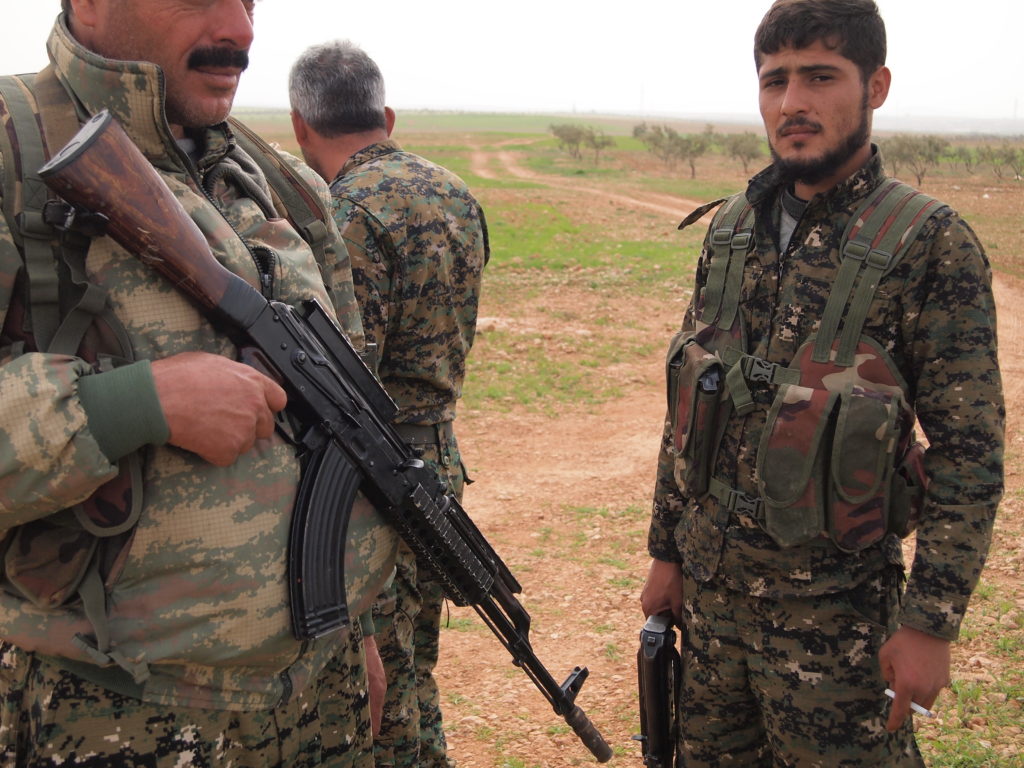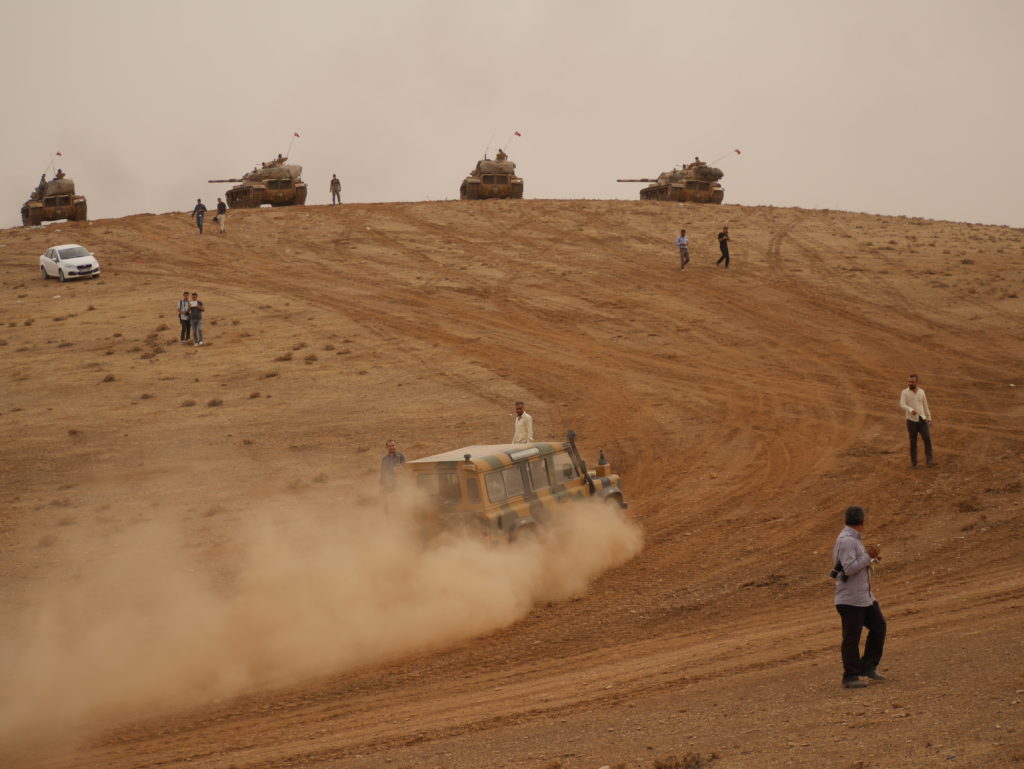
. ©2018 Derek Henry Flood
Thera- In northern, and more recently eastern, Syria, the Syrian Democratic Forces (SDF) emerged as the critical indigenous force in the conventional battle to defeat the so-called Islamic State (IS). The SDF is an aggregate, underfunded outfit comprised of an assortment of war-fighting groups of varying ethno-linguistic composition with attendant local strategic aims. The constituent forces of the SDF, known as military councils or protection units, have agendas that concomitantly compliment and conflict with one another.
The goal to defeat IS brought these armed groups of different provenance together under a unified, Pentagon-endorsed banner. The SDF, as it came to be known, employed both conventional and asymmetric tactics to defeat an army of absolutist salafi-jihadi militants who were holding vast Syrian territory by mid-2014. From its Syrian proto-state, IS temporarily dismembered neighboring Iraq. But presently in late 2019 with IS launching geographically dispersed asymmetric attacks while not holding population centers, the original mission of the SDF in Syria appears conflicted. With wildly mixed messaging from the White House about the United States’ own mission inside Syria where the SDF served as its partner, SDF commanders have been wary of the commitment of their Western backers. Now as the US retreats, public SDF statements are rapidly veering toward outright hostile resentment.
After the SDF’s liberation of the hamlet of Baghouz in the southernmost reaches of Deir ez-Zor governorate along the border with western Iraq in March 2019, the future of the anti-IS umbrella group has remained highly uncertain. Under immense pressure from both regional and extra-regional actors—both state and non-state—the SDF feel utterly abandoned and exploited. They currently face threats from a pre-meditated IS insurgency, the Syrian government and its allies, and now most prominently, the Turkish state and its jingoistic president, Recep Tayyip Erdoğan.
Though media outlets oft describe the SDF as ‘Kurdish-led’ and its core constituent YPG and YPJ militias as “Kurdish militants,’ such wording imposes a degree of oversimplification in terms of ethnic and religious dynamics on the ground. While ethnic Kurds certainly make up the backbone of the SDF in terms of manpower, the American allocation of war materiel, and its upper ranks, it is not an ethnic chauvinist movement bent on forming a separatist state centered on intransigent identity norms.
As the war against IS evolved while expanding further west and south, more diverse factions including former ethnic-Arab Free Syrian Army fighters were absorbed into the SDF. It can be argued that the ideological foundations of the Rojava canton system may have started out as thinly veiled Kurdish-majority institution-building project but, even if only out of sheer pragmatism, this is no longer the ground reality.
This terming emphasising the SDF’s Kurdishness also fuels Ankara’s vociferous concerns that the SDF is a threat to the security of its southern border that necessitated the need for a proposed ‘safe zone’ intended to assuage Turkish security concerns. In the view of the Turkish state, there is zero discernable difference between the PKK’s armed HPG wing and the YPG. An open-ended Turkish presence will provide its armed forces further hard power strategic depth in Syria’s north well beyond that already existing with the Turkish observation posts in Idlib governorate, Operation Olive Branch in forces in Efrin, and Euphrates Shield forces in Jarabulus, and al-Bab.
The constant bellicosity emanating from figures in Ankara has had the SDF’s principal constituent, the YPG, turning its focus away from the IS insurgency as its principal priority and instead preparing for a possible insurgency of its own in northeastern Syria which now appears extremely imminent. Following the bitter loss of the canton of Efrin (Afrin) in northwestern Aleppo governorate to theTürk Silahlı Kuvvetleri (Turkish Armed Forces-TSK) and their local Arab proxies in March 2018, YPG and YPJ veterans fear a repeat of this action writ large. As the YPG and YPJ fought outside of the SDF’s anti-IS framework and under the rubric of ethnic nationalism albeit with Syrian characteristics, a potential future splintering of the SDF was already exposed. The YPG was forced to divert forces away from the front in Deir ez-Zor in what became a futile attempt to protect an isolated pocket of its Rojava canton project.
Meanwhile, in Deir ez-Zor governorate, the SDF’s local constituent there, the Deir ez-Zor Military Council, has been primarily concerned with keeping the forces of the al-Assad government along with Lebanese Hezbollah, Russian military police, Iranian Qods Force detachments, and various Iraqi and other transnational Shia militiamen contained west of the Euphrates. To Deiri fighters, the threat from ‘an-Nizam’ (‘the regime’) is the immediate threat rather than far-off Turkey. Along the length of the Euphrates river, priorities distinctly differ owing to the specificity of localised threat environments.
In the face of a TSK invasion, can the SDF can be sustained as a relatively coherent military force in the Autonomous Administration of North and East Syria, the segments of the disputed governornates it currently secures, in the near to medium term?
Will the SDF umbrella ultimately splinter as the military involvement of great power nations lessens i.e. the United States that looks to be rapidly withdrawing and the Russian Federation, and nearby middle power nations Turkey and Iran continue to meddle applying pressure from all sides? Individual SDF commanders promote the idea of force and ideological cohesion while outlining inconsistent strategic priorities along the frontline with the government and its allies. If the TSK comes in full force in the coming days or weeks-short of some policy reversal miracle-this will likely prove to test the SDF’s mettle against a state actor with an air force while they will not be able to call upon American air power to defend population centres against its NATO ally .
Kurdish and Arab views within the SDF on negotiating with Damascus have until now been divergent and may suddenly be irrelevant as Syrian government forces may create new facts on the ground in Manbij and environs while the SDF orients northward. Can the SDF move forward under a new organizing principle that promotes further unity beyond the fight against IS while being gravely threatened by the Turkish state?
The SDF and its political wing the Syrian Democratic Council (SDC) espouse a federal, decentralized Syria while the al-Assad government insists on restoring the territorial integrity of a unitary, pre-war Ba’athist state that does not allow for political or ethnic pluralism. Washington had been backing the SDF militarily but not the SDC politically while Moscow does both for al-Assad.
How can these two massively disparate visions of a post-conflict Syria possibly be reconciled in the near term that will not result in the SDF being either dismantled or absorbed by the Syrian state? Keep in mind that both the SDF and Syrian Arab Army (SAA) may be at war with the TSK and its local proxy forces in an all-out worst case scenario. A Turkish occupation well beyond the limits 1998 Adana agreement may foment a battlefield-inspired Syrian nationalism whereby the SDF and SAA are pushed together.
With the SDC, and hence the SDF, not being represented in negotiations on Syria’s future outside the country such as the Astana process or the UN’s recently announced Turkish-endorsed Syrian Constitutional Committee, under what circumstances could their autonomous rule gain legitimacy for leverage in talks with Damascus? Of course unless a full-blown TSK invasion is averted, my questions may all be moot.
The issue of Kurdish ethno-nationalism in Syria today differs significantly from contemporaneous issues of armed Kurdish actors in Turkey such as the HPG, the PJAK in Iran, and the KDP and PUK Peshmerga factions in Iraq. The YPG and HPG undoubtedly have a degree of human overlap with Syrian Kurds in the ranks of the HPG in clashes with the Turkish state and Turkish Kurds within the YPG. But the arc of the YPG evolved even further than the mandate of the HPG with the announcement of the SDF’s creation. Despite their shared adherence to Apoism and a some human and materiel crossover, Kurdish fighters in Turkey and Syria are in fact waging different conflicts at the time of this writing. A major unintended effect of a prolonged Turkish operation might that the two war-fighting groups do indeed become one in the same in some form of guerrilla war of attrition against Turkish forces on either side of the border.
While each protection unit or military council retains its on logo and distinct identity, the yellow SDF banner invites a degree of assimilation as a fighting force greater than the sum of its parts. Therefor the YPG as it currently stands gained an even more distinctly Syrian outlook as it formally partnered with non-Kurdish militias. Pivoting from a mostly defensive posture with a fitful modus vivendi with the Syrian government in the two principal cities of Hasakeh governorate, the YPG moved toward an offensive one in the battles for Manbij, and ar-Raqqa backed by American air power.

The threat of IS created a ground level realpolitik dynamic whereby Syria’s Kurds had to partner with ethnic Arabs, Turkmen, Syriacs, Assyrians, and various Caucasian minorities to form a much geographically broader, ethnically inclusive fighting force. While the YPG and YPJ actively promote the concept of Apoism, the ideology of Abdullah “Apo” Ocalan, they do not seek to simply impose it by coercion on other non-Kurdish comrades under the SDF umbrella. Thus contrary to a narrative promoted by the Turkish government, the SDF is not entirely synonymous with the YPG.
Syrian territory in governorate districts that were controlled by IS was used to organize and export religio-political violence in the immediate region, multiple capitals of core European Union member states, the United States and elsewhere. The uncertain future of the SDF’s narrative has far ranging implications not just for Syria and it neighbors but for the world as a whole where technology has enabled militancy to metastasize at light speed outpacing policy makers to become a global phenomenon. The SDF as a military entity may not be sustainable in the long term but until now they have been robustly holding the line in relative geopolitical isolation.
As US special operators have abruptly pulled back from posts on the Turkish border after convincing the SDF to destroy their own fortifications, the West’s core ally against IS in Syria is left to twist in the wind.